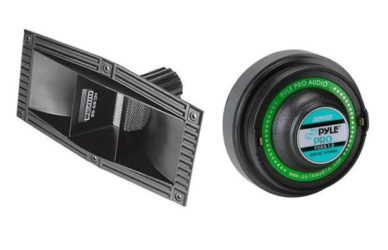| Matching Horns to Compression Drivers
With third party horns and compression drivers, it’s often a hit and miss affair with regards to compatibility. Fig 1 shows three screw mount compression drivers with the Selenium HC23-25 horn. Measurements are RAW, with no crossover. The idea is to check on the frequency response and the horn cut-off. As can be seen, none are satisfactory. The PDS221 (Red trace) at least has some potential as it is fairly flat from 2.5kHz to 10Khz. I wouldn’t even attempt with the other two. |
 (Fig 1) |
| The Blue trace in Fig 2 is with a PRV D280Ti. The response is still not good enough. I tried to screw in my Peavey RX14 but to my dismay, it wouldn’t fit. It got stuck half way in. So much for standard screw thread.
Out of desperation, I mounted a Pyle PDB512 to the HC23-25 with the aid of an adapter (bolt to screw). The black trace is the ensuing response. And lo and behold, I’m on to something. The roll-off looks similar to Constant Directivity horns. |
 (Fig 2) |
| The Black trace in Fig 3 is the PDB512/HC23-25 crossed at 2.5kHz (24dB/oct).
The Blue trace is with the Constant Directivity EQ (CDEQ) activated. Now, the frequency axis is horizontal. I should point out at this stage that the Pyle PDB512 is only good up to 7kHz. Notice the severe notch at 8kHz followed by a burst of high frequencies. I believe that is cone breakup. More on that later. |
 (Fig 3) |
| Fig 4 shows the PDB512/HC23-25 crossed with the Dayton RS180S at 2.5kHz (24dB/oct).
Even though my active crossover is set at 2.5kHz, the drivers are actually crossing acoustically at about 2kHz. |
 (Fig 4) |
| Bad Summing
The Red trace in Fig 5 is the summed response of the RS180S with the PDB512/HC23-25. This is a terrible summing. Due to the offset of the acoustic centers of the RS180S and the PDB512, it resulted in cancellation on the left of the cross point and unwanted summing on the right. |
 (Fig 5) |
| Doing it right
To solve the problem of bad summing, the PDB512 phase is first inverted. Then a delay is added to the RS180S. When the delay time is correct, sounds from the compression driver and the woofer will reach the microphone at the same time. Since the compression driver’s (PDB512) phase is inverted, instead of summing, it will result in a deep notch as shown in Fig 6. Notice the tip of the notch is at the crossover frequency. |
 (Fig 6) |
| Correct Summing with Time-Alignment
The Red trace in Fig 7 is with the PDB512 phase re-wired back to normal. The notch in Fig 5 has completely disappeared. |
 (Fig 7) |
| Sound Quality
Surprisingly, for a compression driver that cost below $30, the Pyle PDB512 exceeded my expectations. It even sounds better than the more expensive Dayton D250P Polyimide driver. What I particularly like about this PDB512/HC23-25 combo is the vocal projection and positioning. Vocals jump out and sound slightly forward, in front of the band. And believe it or not, it doesn’t sound rough. No harshness. Is the Pyle PDB512 good enough for hifi? Personally, my verdict is YES. Even though what I’m getting beyond 8kHz is essentially cone breakup, I don’t find it objectionable because there’s little information up there. But if you demand perfection, it is not difficult to cross it at 7kHz to a super tweeter. Due to it’s low cost, this Pyle and Selenium horn will make a superb 2-way for pro use, especially for vocals. Voices don’t go up to 7kHz, so there’s no benefit having a speaker that extends beyond that. In fact, it would be better to bandwidth limit the speaker. This will reduce the chances of feedback. Matched with a 8″ or 10″ pro woofer, it will make great satellites or stage monitors. Cheap and good. My kind of speakers. All measurements were made with the microphone at 1 meter, on tweeter axis. Gating is at 5 msec and No Smoothing applied. |
 |
 (Fig 8) |
| Update – Nov 11, 2016
Fig 8 is the Distortion measurement of the Pyle PDB512/HC23-25 crossed at 2.5kHz (24dB/oct). Red trace is the 2nd harmonic, Violet is the 3rd. Highest peak of 3rd harmonic is at 4kHz, which is 45dB below fundamental. |
